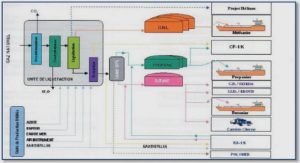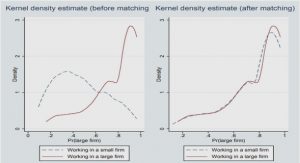Get Complete Project Material File(s) Now! »
Tick anatomy
The anatomy of ticks has been described by Sonenshine (1991), Balashov (1968) and Till et. al., (1961). Ticks are divided into two main regions, the capitulum (gnathosoma or false head) and idiosoma or body. The capitulum comprises the basis capituli, a pair of foursegmented palps, a pair of two-segmented chelicerae and a hypostome. The basis capituli provides anchorage to the flexible mouthparts and also contains the shaft for the chelicerae, the pharynx and salivary ducts. The paired chelicerae are located medial to the palps and on the dorsal aspect of the capitulum (Sonenshine 1991). The hypostome forms the ventral aspect of capitulum. It is the primary organ of tick attachment is ventrally covered by regular rows of denticles (Sonenshine 1991, Zebrowski 1926). Dorsally, the hypostome is concave with a preoral canal through which blood is sucked by the pumping action of the pharynx (Till 1961). The four-segmented palps extend from antero- lateral aspects of the basis capituli (Sonenshine 1991). Dorsally, in females and immature stages, the anterior part of the body is covered by a scutum, posterior to which is the alloscutum, which is characterised by innumerable superficial foldings of the cuticular surface. In males, the scutum covers the entire dorsal part of the body. The scutum bears simple eyes on the lateral margins (Balashov, Raikhel & Hoogstraal 1983, Sonenshine 1991, Till 1961).
On cross section, the body wall (integument) of the tick shows the cuticle and the epidermis. The epidermis lies below the cuticle and comprises a simple cuboidal epithelium resting on a basement membrane (Sonenshine 1991). The body cavity of an ixodid tick is an open hemocoel, bathed with a body fluid, the hemolymph and has several loose connective tissues and membranes supporting various internal organs. Internal organ systems include the digestive, reproductive, respiratory (tracheal), nervous, and circulatory systems (Balashov, Raikhel & Hoogstraal 1983, Sonenshine 1991, Till 1961). The digestive system organs include the preoral canal, the salivary glands, the pharynx, oesophagus, midgut and hindgut. Salivary glands comprise a pair of grape-like clusters extending antero-posteriorly along the lateral sides of the body (Balashov 1972, Sonenshine 1991, Till 1961, Walker, Fletcher & Gill 1985). The units of salivary glands are alveoli (acini) and each alveolus comprises 10-12 nucleated cells located around a central cavity (lumen), which flows into an alveolar duct. The lobular ducts flow into a short lobular duct and finally into a common duct (Zebrowski 1926).
The salivary glands comprise three types of alveoli in females and four in males (Sauer, Essenberg & Bowman 2000, Walker, Fletcher & Gill 1985). On the basis of types of cells contained, the salivary gland alveoli may be agranular (type 1) or granular (types 2, 3 & 4). Type 1 alveoli are made up of agranular cells and are confined to the main ducts (Till 1961, Walker, Fletcher & Gill 1985). The foregut (mouth parts) comprises the preoral canal, pharynx and oesophagus. The preoral canal lies on the floor of the hypostome. It distally leads to the pharyngeal valve and pharynx proper. The pharynx is located about the centre of the basis capituli and it serves as a pump organ for the suction of blood (Sonenshine 1991, Zebrowski 1926). The mouthparts are lined by cuticle and a single layer of squamous cells. The oesophagus connects the pharynx and the midgut. It is a thin cuticle lined tube. It passes through the synganglion, entering it at the antero-ventral margin and emerging from the postero-dorsal edge. It forms a fold with muscle bundles, the proventricular valve, at its junction with the midgut, believed to prevent regurgitation of blood back from the midgut to the oesophagus (Balashov, Raikhel & Hoogstraal 1983, Balashov 1972, Sonenshine 1991, Till 1961, Zebrowski 1926). The midgut is the largest organ in the tick. It comprises a central ventriculus, an equivalence of the stomach with paired tube-like diverticular or caeca with blind ends (Balashov 1972, Zebrowski 1926). The midgut comprises an epithelium whose cell composition varies according to stage of feeding. Unfed ticks have been described to contain undifferentiated (stem) cells and some digestive cells (Coons et al. 1986, Sonenshine 1991).
Feeding and salivation
All active stages of the ticks are parasitic and require a blood meal to engorge before moulting to the next stage. Adult (male and female) ticks require the blood meal for sperm and egg production, respectively (Cupp 1991, Sonenshine 1991). Ticks are telmophagous, i.e., the chelicerae slash through the superficial layers of the skin and lacerate the capillary bed so that a pool of blood is formed subdermally and it is from this that the tick is able to feed. As the tick attaches, ixodid tick species secrete saliva, which contains pharmacological products that enable the ticks to successfully obtain their blood meal. The saliva, secreted on attachment, contains a white milky substance secreted by types II and III alveoli. This protein forms a cement cone that solidifies and adheres the tick mouth parts to the host skin (Bowman&Sauer 2004, Cupp 1991, Gregson 1960). Tick salivary gland secretions also include anti-coagulants, which inhibit thrombokinase, responsible for blood clotting. Ixodes dammini secretes enzyme apyrase, which prevents platelet aggregation. Tick salivary secretions also have vasoconstrictive mediators, prostaglandin E2 (PGE2) and prostacyclin. The combined effects of these agents is to prevent hemostasis, vasoconstriction and the coagulation cascade which ensures a continuous flow of blood in a fluid form (Benavides Ortiz & Walker 1992, Ribeiro, Makoul & Robinson 1988, Ribeiro, Weis & Telford 1990, SáNunes et al. 2007).
Saliva also contains proteins which cause immuno-modulation, which impairs host response to invasion (Chinery 1981, Marchal et al. 2011, Randolph 2009). The chemical agents in tick saliva include immunoglobulin G (IgG) binding proteins which remove host IgG that crosses the midgut and ultimately saving the haemocoel tissues from harm. Iinterleukin-2 (IL-2) binding protein, which binds to host cells with IL-2 receptors such as T-cells, B-cells, natural killer (NK) cells, cytotoxic T-cells, monocytes and macrophages is also present (Brossard & Wikel 1997, Brossard & Wikel 2004, Wikel, Ramachandra & Bergman 1994). Rhipicephalus microplus was seen to cause a reduction of peripheral blood lymphocytes (Inokuma et al. 1993). The ultimate effect is the suppression of both the classical and alternate complement pathways and failure of the host to recognise the presence of the ticks (Inokuma, Kemp & Willadsen 1994, Marchal et al. 2011, Randolph 2009). Once feeding starts, the accumulation of blood in the midgut, creates a hypo-osmotic condition (Kaufman 1973). The excess water and ions are removed from the blood meal and move across the gut epithelium into the hemocoel from where they are transported to the salivary glands. The salivary glands produce watery saliva that is injected back into the host (Cupp 1991, Hsu & Sauer 1975). A 5- to 30s cyclic pattern of alternating sucking and salivation starts, with durations of blood sucking lasting longer than those of salivation, interrupted by periods of relative inactivity (Gregson 1960, Kaufman 1989). The process of constant removal of excess water and ions from the tick body helps in osmoregulation and enables the ticks, especially females, to concentrate their blood meal and take in large quantities of blood (Hsu & Sauer 1975, Kaufman 1973, Sonenshine 1991).
Amblyomma hebraeum
Male (F1 adult) A. hebraeum ticks were placed in containment bags attached to the body sides of donor animals (DA1 and DA2) on Day 4 pi, and since A. hebraeum females will only attach in response to aggregation and attachment pheromones secreted by males that have fed for at least four days (Norval, Andrew & Yunker 1989, Norval et al. 1992), 250 males were 4 days before the females (150) on each donor animal. On Day 12 pi, 200 A. hebraeum males from each of the two donor animals were transferred to recipient animals (RA1 and RA2) to test for intrasstadial/mechanical transmission. In addition, these ticks were tested by real-time PCR and VI for mechanical/intrastadial persistence of LSDV in the ticks. Another set of 75 F1 A. hebraeum males were placed on donor animal DA3 as above. Four days later (Day 8 pi), 25 females were added to the group of feeding males. All ticks were collected after another 4 days (Day 12 pi) to test for mechanical/intrastadial passage of LSDV by detecting the virus in tick saliva and organs.
Engorged F1 A. hebraeum females were collected, incubated and allowed to lay eggs as described for R. appendiculatus and R. (B) decoloratus females above. After a period of two months to allow for maturation, approximately 2,500 emergent (F2) A. hebraeum larvae were placed on recipient animal RA4 to test for transovarial transmission and approximately 500 larvae were tested for transovarial passage of LSDV by real-time PCR (Figure 2.3). Amblyomma hebraeum nymphs were placed on the ear bags of donor animals (DA1 and DA2) (Figure 2.4) and were collected after repletion. As in R. appendiculatus above, they were incubated to moult into F2 adults. To test for transstadial transmission, 200 A. hebraeum F2 A. hebraeum males were placed on each of the recipient animals RA5 and RA6 on Day 0 pa and 4 days later (Day 4 pa), A. hebraeum females were added to the containment bags with males. On Day 8 pa, 100 males and partially fed females were collected to test for transstadial passage by detection of LSDV in tick saliva and organs.
Chapter 1 Literature review
1.1. Introduction
1.2 Lumpy skin disease epidemiology
1.3 Economic importance
1.4 The virus
1.5 Lumpy skin disease
1.6 Transmission
1.7 Biology of ticks
1.8 Tick species used in this study
1.9 Laboratory diagnosis of lumpy skin disease
1.10 Objectives of the study
1.11. References
Chapter 2 Materials and Methods
2.1. Cattle
2.2. Preparation of the virus inoculum
2.3. Ticks
2.4. Artificial infection of donor animals with LSDV
2.5. Testing for LSDV persistence and transmission by ticks
2.6. Collection of specimens from animals
2.7. Clinical monitoring of animals
2.8. Collection of saliva from ticks
2.9. Tick dissection
2.10. Homogenisation of tick samples
2.11. Virus isolation
2.12. Serum neutralisation test
2.13. Real-time Polymerase chain reaction
2.14. Immunohistochemistry
2.15. Transmission electron microscopy
2.16. References
Chapter 3 Evidence of transstadial and mechanical transmission of lumpy skin disease virus by Amblyomma hebraeum ticks
3.1 Introduction
3.2. Materials and Methods
3.3. Results
3.4. Discussion
3.5. References
Chapter 4 Detection of lumpy skin disease virus in saliva of ticks fed on lumpy skin disease virusinfected cattle
4.1. Abstract
4.2. Introduction
4.3. Materials and methods
4.4. Results
4.5. Discussion
4.6. Reference
Chapter 5 Transovarial passage and transmission of LSDV by Amblyomma hebraeum, Rhipicephalus appendiculatus and Rhipicephalus (Boophilus) decoloratus
5.1. Abstract
5.2. Introduction
5.3. Materials and methods
5.4. Results
5.5. Discussion
5.6. References
Chapter 6 Demonstration of lumpy skin disease virus infection in Amblyomma hebraeum and Rhipicephalus appendiculatus ticks using immunohistochemistry
6.1. Abstract
6.2. Introduction
6.3. Materials and methods
6.4. Results
6.5. Discussion
6.6. References
Chapter 7 Evidence of lumpy skin disease virus over-wintering by transstadial persistence in Amblyomma hebraeum and transovarial persistence in Rhipicephalus (Boophilus) decoloratus ticks
7.1. Abstract
7.2. Introduction
7.3. Materials and methods
7.4. Results
7.5. Discussion
7.6. Reference
Chapter 8 General discussion






